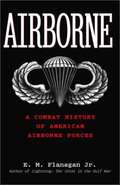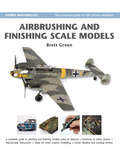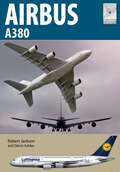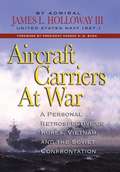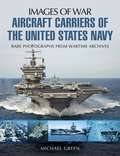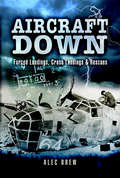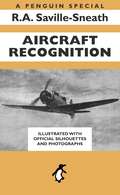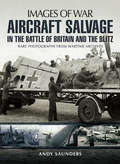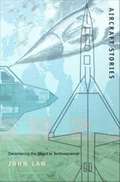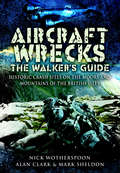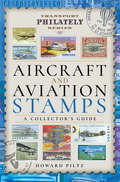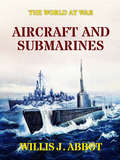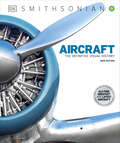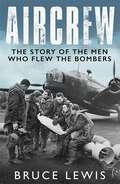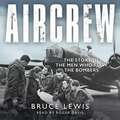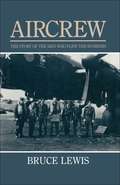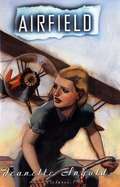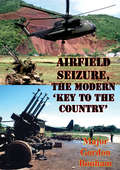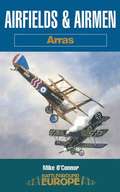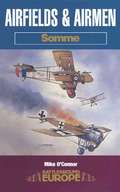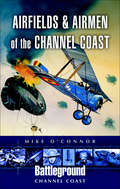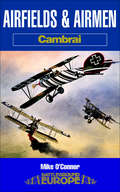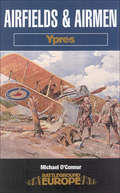- Table View
- List View
Airborne: A Combat History of American Airborne Forces
by Edward M. Flanagan Jr.A combat history of American airborne forces up to the Gulf War.
Airbrushing and Finishing Scale Models
by Brett GreenA convincing paint finish is essential for any model, be it military or civilian, aircraft, vehicles, figures or even background items such as terrain or buildings - and good airbrushing and finishing techniques can be the key to creating a superior model. Over the last few years there have been huge strides made in the development of airbrushes, paints and thinners, and consequently, this new book will provide up-to-date practical information and illustrated techniques to take full advantage of these new technologies.Brett Green details the prerequisites of airbrushing, including the different types of spray equipment and air sources available, offering advice on appropriate thinners, paint ratios and air pressures to ensure the most appropriate paint coverage across a range of different airbrushing applications. He then examines various airbrushing techniques across a wide range of models. Ten step-by-step, illustrated case studies ranging from heavily weathered military aircraft to pristine, high gloss motor vehicles, science fiction models, fantasy figures, groundwork and buildings will complete this in-depth guide to getting the best results on your models.From the Hardcover edition.
Airbus A380 (Flight Craft #23)
by Robert Jackson Glen Ashley“A great addition to the highly popular Flight Craft Series. This book reviews the history of . . . an iconic and important aircraft in civil aviation.” —FiretrenchOn April 27 2005, an aircraft under the power of six massive Rolls-Royce Trent 900 turbofan engines was making its first flight, and it was making history. For this was the Airbus A380, the largest passenger aircraft in the world. With air traffic continuing to double every fifteen years, the A380 was designed by Airbus Industrie to meet the needs of the passengers and airports, while also delivering the level of efficiency necessary to protect the environment for future generations. The design incorporated two full-length decks with wide-body dimensions, meaning its two passenger levels offered an entire deck’s worth of additional space compared to the next largest twin-engine jetliner. With more seats than any other aircraft, the A380 offered solutions to overcrowding; needing fewer journeys to carry 60 percent more passengers, making it the perfect solution to airport congestion, fleet planning optimization and traffic growth. Typical seating capacity was 525, although the aircraft was certified to carry up to 853 passengers. Production of the A380 peaked at thirty aircraft per year in 2012 and 2014. Then, in February 2019, the biggest customer, Emirates, announced that it was to reduce its latest order by thirty-nine aircraft in favour of two other Airbus Models, the A350 and A330neo, a version using the same engines as the Boeing 787 Dreamliner. For Airbus, it was the last act. The Company announced that production of the A380 would cease by 2021.“Full of great information.” —Airport Spotting
Aircraft Carrier Victorious: Detailed in the Original Builders' Plans
by David HobbsThe technical details of British warships were recorded in a set of plans produced by the builders on completion of every ship. Known as the as fitted general arrangements, these drawings represented the exact appearance and fitting of the ship as it entered service. Intended to provide a permanent reference for the Admiralty and the dockyards, these highly detailed plans were drawn with exquisite skill in multi-coloured inks and washes that represent the acme of the draughtsmans art.Today they form part of the incomparable collection of the National Maritime Museum at Greenwich, which is using the latest scanning technology to make digital copies of the highest quality. This book is one of a series based entirely on these draughts which depict famous warships in an unprecedented degree of detail complete sets in full colour, with many close-ups and enlargements that make every aspect clear and comprehensible. Extensive captions point the reader to important features to be found in the plans, and an introduction covers the background to the design.HMS Victorious was a ship with two almost separate incarnations as built in 1941 she was one of a new type of armoured carrier which saw strenuous wartime service; post-war the ship underwent a massive reconstruction lasting nearly eight years that saw her recommission in1958 as one of the best equipped carriers in the world, ready for another decade of duty. Both these phases of the ships life are fully documented, which allows this novel form of anatomy to cover two generations of carrier design.
Aircraft Carriers at War
by James L. Holloway IIIAdm. James Holloway describes this book as a contemporary perspective of the events, decisions, and outcomes in the history of the Cold War Korea, Vietnam, and the Soviet confrontation that shaped today s U.S. Navy and its principal ships-of-the-line, the large-deck, nuclear-powered aircraft carriers. Without question, the admiral is exceptionally well qualified to write such an expansive history. As a carrier pilot in Korea, commander of the Seventh Fleet in Vietnam, Chief of Naval Operations in the mid-1970s, and then as a civilian presidential appointee to various investigative groups, Holloway was a prominent player in Cold War events.Here, he casts an experienced eye at the battles, tactics, and strategies that defined the period abroad and at home. Holloway's first-person narrative of combat action conveys the tense atmosphere of hostile fire and the urgency of command decisions. His descriptions of conversations with presidents in the White House and of meetings with the Joint Chiefs in the war room offer a revealing look at the decision-making process. Whether explaining the tactical formations of road-recce attacks or the demands of taking the Navy s first nuclear carrier into combat, Holloway provides telling details that add valuable dimensions to the big picture of the Cold War as a coherent conflict. Few readers will forget his comments about the sobering effect of planning for nuclear warfare and training and leading a squadron of pilots whose mission was to drop a nuclear bomb.Both wise and entertaining, this book helps readers understand the full significance of the aircraft carrier s contributions. At the same time, it stands as a testament to those who fought in the long war and to the leadership that guided the United States through a perilous period of history while avoiding the Armageddon of a nuclear war.
Aircraft Carriers of the United States Navy: Rare Photographs From Wartime Archives (Images of War)
by Michael GreenThis pictorial history of US aircraft carriers illustrates the many classes and types of carriers used by the navy from before WWII to the present day. In 1922 the US Navy commissioned its first small experimental aircraft carrier. This was followed into service by two much larger carriers in 1927 with five more being built— including three large Yorktown class—prior to the Japanese attack on Pearl Harbor. Then, to take the offensive against the Japanese Navy, the American Congress funded by far the largest carrier-building program in history. Since 1975, when the first of a fleet of ten nuclear-powered Nimitz class carriers was commissioned, The United States Navy&’s fleet of carriers has optimized its superpower status and worldwide power projection. Yet these are due to be replaced in the decades to come with the even more sophisticated nuclear-powered Gerald R. Ford class. Compiled and written by Michael Green, Aircraft Carriers of the United States Navy contains superb images of all the different types of classes of carriers employed by the US Navy since 1922. These and its highly informative text and captions give the reader a broad overview of this fascinating subject.
Aircraft Down: Forced Landings, Crash Landings and Rescues
by Alec BrewTwenty-three compelling accounts of desperate circumstances and unbelievable survival when planes went down in remote and dangerous locations.When a pilot experiences a sudden loud bang or sudden total silence, he is often faced with the stark choice of the parachute or attempting to get the aircraft down to earth in as few pieces as possible. This book describes twenty-three remarkable and true instances when, for a variety of reasons, all seems lost—but life was not. These life-threatening incidents range through the history of powered flight and all over the globe from Arctic waste to desert sand and from English hillside to coral reef. Within the narrative are moments of humor, despair and utter joy. The author has gleaned his information from a myriad of sources and many personal accounts. For those who love to read of the human spirit and its determination to survive against all odds—this book makes splendid reading.
Aircraft Recognition: A Penguin Special
by R.A. Saville-SneathWhen this book was first published in 1941, aircraft recognition was far more than just a pleasant pastime; it was often a matter of life and death… This classic text provides a definitive catalogue of the aeroplanes, enemy and friendly, seen over British skies during the Second World War. R.A. Saville-Sneath set out to produce a handy classification guide, with many diagrams, a full glossary and some useful mnemonics, showing how each type of aircraft could be identified quickly and easily. The basic structures, tail units, positions of the wings and engines, and even the sounds made by the different planes, form part of the essential 'vocabulary' for distinguishing Albacores and Ansons, Beauforts and Blenheims, Heinkels, Hurricanes and Junkers, Messerschmitts and Moths, Spitfires and Wellingtons. For anyone interested in aviation the book provides a mine of information about a golden age. For those who lived through one of the most glorious episodes in the history of combat it will prove vividly evocative of those extraordinary days.
Aircraft Salvage in the Battle of Britain and the Blitz: Aircraft Salvage in the Battle of Britain and the Blitz (Images Of War Bks.)
by Andy SaundersAircraft Salvage in the Battle of Britain and Blitz will comprise of some 140-150 images of the work of RAF and civilian salvage squads during the Battle of Britain, the Blitz and beyond. The images will depict losses across Britain, both RAF and German, during this period. Each picture will tell its own story, and will be fully captioned with historical detail. The author will be covering a topic that has rarely been examined in this detail.Each section will have a short introduction and the images will include those of shot down aircraft, including relatively intact machines, badly damaged/destroyed wreckages, photographs of pilots and other related illustrations. All images are from the authors unique collection of wartime photographs of Luftwaffe losses, collected from a variety of sources across some thirty-five years of research.
Aircraft Stories: Decentering the Object in Technoscience
by John LawIn Aircraft Stories noted sociologist of technoscience John Law tells "stories" about a British attempt to build a military aircraft--the TSR2. The intertwining of these stories demonstrates the ways in which particular technological projects can be understood in a world of complex contexts. Law works to upset the binary between the modernist concept of knowledge, subjects, and objects as having centered and concrete essences and the postmodernist notion that all is fragmented and centerless. The structure and content of Aircraft Stories reflect Law's contention that knowledge, subjects, and--particularly-- objects are "fractionally coherent": that is, they are drawn together without necessarily being centered. In studying the process of this particular aircraft's design, construction, and eventual cancellation, Law develops a range of metaphors to describe both its fractional character and the ways its various aspects interact with each other. Offering numerous insights into the way we theorize the working of systems, he explores the overlaps between singularity and multiplicity and reveals rich new meaning in such concepts as oscillation, interference, fractionality, and rhizomatic networks. The methodology and insights of Aircraft Stories will be invaluable to students in science and technology studies and will engage others who are interested in the ways that contemporary paradigms have limited our ability to see objects in their true complexity.
Aircraft Wrecks: Historic Crash sites on the Moors and Mountains of the British Isles
by Alan Clark Nick Wotherspoon Mark SheldonThis book gives readers a direct link to crash sites that can be visited, with accurate grid references, site description and current photographs. It covers some 450 selected sites with emphasis given to those on open access land. The areas covered are: Southern England: Dartmoor and Exmoor 20 entries * Wales 120 entries * Isle of Man 20 entries Peak District 75 entries * Yorkshire Moors: Eastern 20 entries * Lake District 25 entriesPennines: East Lancashire & West Yorkshire * Scotland: Central and Southern 30 entriesScotland: Highlands & Islands * Ireland 20 entries Each area includes a preamble describing the local geography and historical notes. Individual site entries include exact location, details of the aircraft and crew and the circumstances of the loss.
Aircraft and Aviation Stamps: A Collector's Guide (Transport Philately Series)
by Howard PiltzSoar around the world with this illustrated guide to postage stamps that commemorate the history of flight.In his series of collector’s guides, Howard Piltz combines his two greatest interests: transport and stamps. This volume focuses on aircraft and aviation, highlighting stamps from numerous countries that feature miniature works of art celebrating achievements from early military planes to sleek passenger jets to helicopters, and marking many of the great moments in aviation history.Philatelists and transportation buffs will enjoy not only the photos of stamps themselves but the stories of the author’s research, facts about countries and continents, and some tips and terms for those who are just beginning their adventure in stamp collecting.
Aircraft and Submarines: The Story Of The Invention, Development, And Present-day Uses Of War's Newest Weapons (classic Reprint) (The World At War)
by Willis J. Abbot(Excerpt) "Not since gunpowder was first employed in warfare has so revolutionary a contribution to the science of slaughtering men been made as by the perfection of aircraft and submarines. The former have had their first employment in this world-wide war of the nations. The latter, though in the experimental stage as far back as the American Revolution, have in this bitter contest been for the first time brought to so practical a stage of development as to exert a really appreciable influence on the outcome of the struggle."
Aircraft: The Definitive Visual History (DK Definitive Transport Guides)
by DKTake an action-packed flight through the history of aircraft and discover the intrepid pioneers who made a dream realityUncover the engineering behind more than 800 aircraft models, from military jets to commercial planes. This visual history book captures the fascinating story of airplanes and aviation, and how their groundbreaking discovery has influenced the 21st Century.Inside the pages of this aircraft book, you&’ll discover: • The history of military and commercial aircraft from all over the world, decade by decade, to the present day in stunning visual detail • Comprehensive catalogs highlight the most important aircraft of each period along with their specifications and unique features • Showcases on particularly celebrated aircraft – such as the Supermarine Spitfire and Concorde – in beautifully photographed &“virtual tour&” features • The stories of the engineers and manufacturers that created marques like Boeing and Airbus Take to the skies Modern flight has opened the world up to new opportunities and paved the way for the development of advanced research and technology. But, what made it so groundbreaking? This book uncovers the stories behind the first airplane models, the development of flight, and brings you to present-day marvels such as the Gypsy Moth and Supermarine Spitfire.The Aircraft Book is filled with stats, facts, and photographs that create a visual tour and allows you to see inside key commercial and military aircraft models from the exterior to the cockpit. Aviation enthusiasts will also be captivated by the manufacturer of aircraft engines and how famous models like Boeing and Lockheed became household names. Love history? Discover even more with DK!DK's The Definitive Visual History series is an iconic celebration of design and history. Packed with fascinating facts and statistics, these high-quality visual guides cover everything from history and notable designs to the people and technology that made it possible. Books in this series include The Car Book, The Train Book, The Tank Book, and so much more.
Aircrew: Dramatic, first-hand accounts from World War 2 bomber pilots and crew
by Bruce LewisA vivid, first-hand account of the tension and excitement of flying missions over Nazi GermanyThe British and American bomber crews of the Second World War often had to endure the most terrifying conditions. Not for them the glorious, all-or-nothing exhilaration of the Battle of Britain pilots - rather, the slow dwindling of courage as mission followed mission, the long, freezing, ear-shattering journey to the target, the bursting flak, the prowling night fighters. Then, if they were lucky, the long haul home, sometimes nursing a battered, barely flyable machine, often perilously short of fuel.Bruce Lewis flew in thirty-six such raids. In this book he records, in his own words and those of his fellow survivors, the events that made operational flying such a fearful experience.This is a blisteringly honest account of life for the Second World War bombers.
Aircrew: Dramatic, first-hand accounts from World War 2 bomber pilots and crew
by Bruce LewisA vivid, first-hand account of the tension and excitement of flying missions over Nazi GermanyThe British and American bomber crews of the Second World War often had to endure the most terrifying conditions. Not for them the glorious, all-or-nothing exhilaration of the Battle of Britain pilots - rather, the slow dwindling of courage as mission followed mission, the long, freezing, ear-shattering journey to the target, the bursting flak, the prowling night fighters. Then, if they were lucky, the long haul home, sometimes nursing a battered, barely flyable machine, often perilously short of fuel.Bruce Lewis flew in thirty-six such raids. In this book he records, in his own words and those of his fellow survivors, the events that made operational flying such a fearful experience.This is a blisteringly honest account of life for the Second World War bombers.
Aircrew: Dramatic, first-hand accounts from World War 2 bomber pilots and crew
by Bruce LewisA vivid, first-hand account of the tension and excitement of flying missions over Nazi GermanyThe British and American bomber crews of the Second World War often had to endure the most terrifying conditions. Not for them the glorious, all-or-nothing exhilaration of the Battle of Britain pilots - rather, the slow dwindling of courage as mission followed mission, the long, freezing, ear-shattering journey to the target, the bursting flak, the prowling night fighters. Then, if they were lucky, the long haul home, sometimes nursing a battered, barely flyable machine, often perilously short of fuel.Bruce Lewis flew in thirty-six such raids. In this book he records, in his own words and those of his fellow survivors, the events that made operational flying such a fearful experience.This is a blisteringly honest account of life for the Second World War bombers.
Aircrew: The Story of the Men Who Flew the Bombers
by Bruce LewisBruce Lewis brings this book together to tell the story of the men who flew the bombers. The different roles within the aircraft are covered and each of their unique experiences discussed through first hand accounts.
Airfield
by Jeanette IngoldIn the early days of aviation, Beatty and Moss hang out around the airport Beatty's uncle manages. Beatty's hoping to see her father when he flies in--and quickly out again--on a mail flight. And Moss is hoping his mechanical skills will help him to support himself. Neither anticipates their crucial roles in the airfield's survival--or in saving Beatty's father's life.
Airfield Seizure, The Modern 'Key To The Country'
by Major Gordon C. BonhamThis monograph examines the key determinants necessary for the successful forced entry seizure of an airfield. The importance of contingency operations is paramount to the United States military as it transitions from "forward defense" to "CONUS based." The ability to project power into an isolated objective area requires the rapid deployment and forced entry of a tailored force package. For many of our current OPLANS, the seizure of an airfield serves as a lodgment area for the introduction of combat power into the objective. The success of the entire contingency operation, in large part, depends upon the successful seizure of the airfield.The monograph analyzes three historical cases of airfield seizures using the Wass de Czege combat power model. Operation Mercury (Crete, 1941), Operation Urgent Fury (Grenada, 1983), and Operation Just Cause (Panama, 1989) are examples of operations that introduce combat power into the objective area. This analysis identifies the key determinants for the successful forced entry seizure of an airfield.This study concludes that an airfield seizure is fundamentally a deliberate attack to seize a terrain oriented objective. Success is achieved by the synchronization of maneuver, firepower, and protection by capable leadership. However, the unique nature of an airfield seizure requires special application of the four elements of combat power to ensure mission accomplishment.
Airfields & Airmen: Arras (Battleground Europe)
by Mike O'ConnorA historical/traveler&’s guide to the World War I aerial events around Arras, France, featuring ace pilots, airfields, and other local points of interest. The latest volume in the Airfields and Airmen series covers the Arras area. It includes a visit to the grave of Albert Ball VC and the graves of Waterfall and Bayly, the first British fliers killed in action. There is a visit to the aerodrome from which Alan McLeod took off from to earn his VC and to the grave of Viscount Glentworth, killed while flying with 32 Squadron. The German side is well covered with visits to their cemeteries and aerodromes. This well researched book relives the deadly thrills of war in the air over the battlefields of the Western Front.
Airfields & Airmen: Somme (Battleground Europe)
by Mike O'ConnorThe latest volume in the Airfields and Airmen series covers the Arras area. It includes a visit to the grave of Albert Ball VC and the graves of Waterfall and Bayly, the first British fliers killed in action. There is a visit to the aerodrome from which Alan McLeod took off from to earn his VC and to the grave of Viscount Glentworth, killed while flying with 32 Squadron. The German side is well covered with visits to their cemeteries and aerodromes. This well researched book relives the deadly thrills of war in the air over the battlefields of the Western Front.
Airfields and Airmen of the Channel Coast (Battleground Channel Coast)
by Mike O'Connor“Takes a seemingly mundane subject as airfields and turns it into a fresh understanding of air combat on the Western Front . . . recommended highly.” —Over the Front In this latest addition to the Airfields and Airmen Series, Mike O’Connor describes the dramatic air actions that took place along the Belgian and North France coastline during The Great War.In addition to the Royal Fighting Corps and RAF aspect this volume covers the Royal Naval Air Service (RNAS) and Belgian Air Service (AMB) as well as the German Naval Air Service. “[This book] is well-illustrated with both recent and historic photos and exudes the author’s knowledge of, and delight in, his subject.” —Warships International“I have championed this series before as the perfect aeronautical travelling companion for journeys across to France from the UK, and this new addition does nothing to diminish my enthusiasm for them.” —Aviation News
Airfields and Airmen: Cambrai (Battleground Europe)
by Mike O'ConnorAirfields and Airmen:Cambrai covers the earliest days of the RFC with the retreat from Mons. We visit the graves of Fokker Eindecker aces and the airfields where the first Jastas were formed. Also covered are airfields from which Allied aces such as Beauchamp and Proctor VC flew, and there is a visit to the American cemetery at Bony that contains a number of aviators.
Airfields and Airmen: Ypres (Battleground Europe)
by Michael O'ConnorThe Battleground Europe series has helped create a new audience for the story of the desperate battles of World War I, But up to now the series has largely been concerned with the ground war. Popular demand has inspired the editors to create a new series of guides to the air war 1914–1918. The first volume is devoted to the Ypres Salient, the northernmost sector of the Western Front. Here the Royal Flying Corps battled the German Imperial Air Service for supremacy over the battlefield, while the Royal Naval Air Service attempted to intercept Germany's Zeppelins and early long-range bombers before they could reach the skies over London.The airfields, battle and crash sites, and monuments associated with the air war in the Ypres sector are covered with all the then-and now detail expected by battleground Europe readers. The dramatic text is backed up with numerous maps, photographs and an extensive bibliography.
